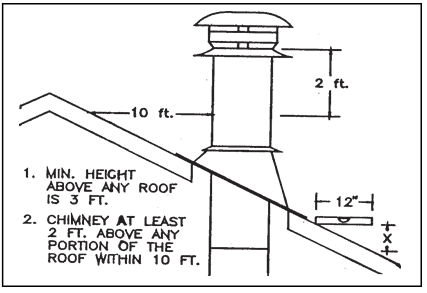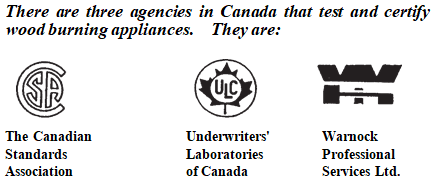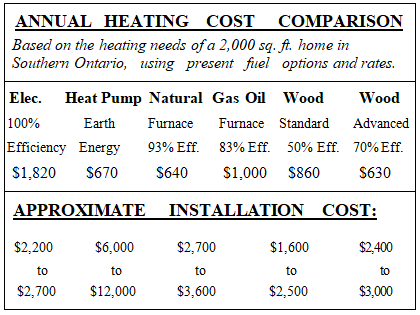COMPONENTS OF A WOOD BURNING STOVE:
Floor Pads: Although certified wood stoves will not overheat floors, live embers that fall from the wood stove can be a fire hazard. The floor pad must be made of a durable non-flammable material, such as sheet metal, grouted ceramic tile or mortared brick. The pad must extend at least 450 mm. (18in.) in front of the loading door, and 200 mm. (8 in.) at the sides and the back. This pad should not be installed on carpeting.
The Stove: Wood stoves vary greatly in their output ranges as well as their price. Some are very small and designed to act as area heaters, and may cost as little as $400 to $600. Larger models, designed to be the main heating source of the home, can range upwards from $1500. It is important that the stove be sized properly to the heating needs of the home. Over-sizing results in extended periods of low firing that can cause trouble. It is best to get advice from an experienced wood stove retailer since they know how to match a stove to your heating needs.They are trained to look at the performance of the unit and the area it is intended to heat. Most people want the stove to take up as little space as possible. Although manufacturers specify the minimum clearances for a particular model, these clearances can be changed with the use of special shields which maintain an air space between the shield and the wall. These are made of either sheet metal, brick, or ceramic tiles,and must be permanently mounted to the wall.
Flue Pipe: There are certain rules for the connection of these flue pipes to the chimney in order to ensure safety. The assemblies must be short and direct to maintain a good draft. A straight rise with no elbows is ideal because it offers the least restriction to gas flow and is low maintenance due to decreased creosote. Creosote is the residue left behind after the wood has burned. It is a black tar-like substance that is highly combustible and attaches itself to the inside wall of the chimney. There are double-walled flue pipe systems that allow less clearances than single wall pipes. The double- walled vented pipes can be either sealed or vented. Sealed pipes are used if the assembly is long or the stove produces slow flue gas temperatures. Vented pipes allow cool air to pass between the inner and outer layers: these can be used where the length of the flue is very short but it is not a good choice for stoves that produce low flue gas temperatures.
The Chimney: The selection, location, and installation of the chimney is just as important as the stove purchased. When properly designed, a chimney will provide years of reliable service. The function of the chimney is to produce a draft to expel the exhaust gas to the outside. When the chimney is filled with hot gas,the gas rises because it is less dense than the air outside.This rising gas creates a pressure difference or draft — the hotter the gas, the stronger the draft.




